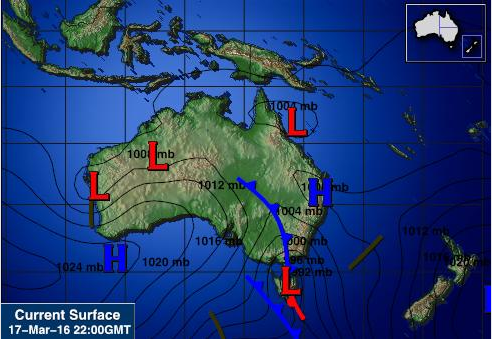The climate of Australia is a mix of tropical and extratropical influences. Eastern-northeastern Australian rainfall is strongly influenced by the ENSO cycles, with La Nina years typically associated with wet conditions and more frequent and intense tropical cyclones in summer and El Nino years with drier than normal conditions, most notably in spring. Over southeastern Australia, the decreasing rainfall trend is the largest in autumn with sustained declines during the drought. A recent analysis shows that climate projections over Australia using CMIP5 models which generally simulate the climate of of Australia well, are highly consistent (Fyfe 1273, 1274, 1275).
In Australia, the regional climate is changing very quickly. The region continues to demonstrate long-term trends towards higher surface air and sea surface temperatures. There will be more extreme cold and extreme hot. In the last 50 years, increasing greenhouse gases have contributed to rising average temperatures in Australia. This warming is continued to increase throughout the years. The warming is expected to be associated with rising snow lines. Annual average rainfall is expected to decrease in southwestern Australia. There is an uncertainty in projected rainfall changes, which creates significant challenges for adaptation. These scenarios would have severe implication for agriculture, rural livelihoods, ecosystems, and urban water supply, and would increase the need for transformational adaptation. Without these adaptations, further changes in climate, atmospheric CO2 and ocean acidity are projected to have substantial impacts on water resources. While adaptation is already happening, it is becoming embedded in some planning processes, albeit mostly at the conceptual rather than implementation level.
Australia exhibits a wide diversity of climates, such as moist tropical monsoonal, arid, and moist temperature, including alpine conditions. There is high confidence that climate change is already affecting the oceans around Australia and warming the Tasman sea in the northern New Zealand. The marine ecosystems of both countries are considered hotspots of global marine biodiversity with many rare, endemic, and commercially important species. I chose this issue because marine ecosystem and wildlife play an important role in Australia's tourism. If this gets affected, it will cause a chain reaction to the country's economy. It will affect tourism if something happens to their wildlife, which will affect their economy.
The figure above shows the locations in Australia that are vulnerable.








